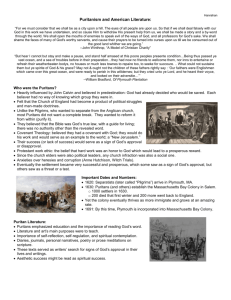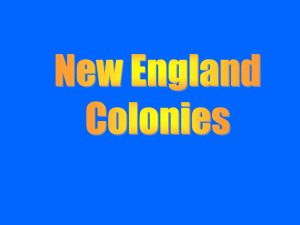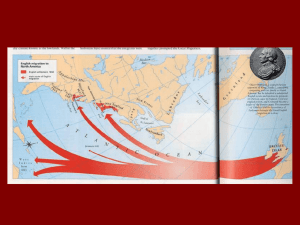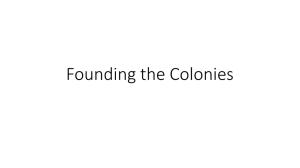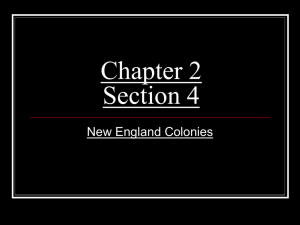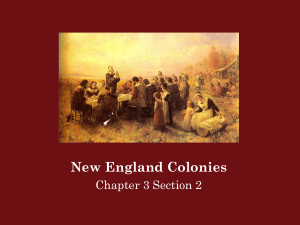British Colonization: Settling the Northern Colonies
advertisement
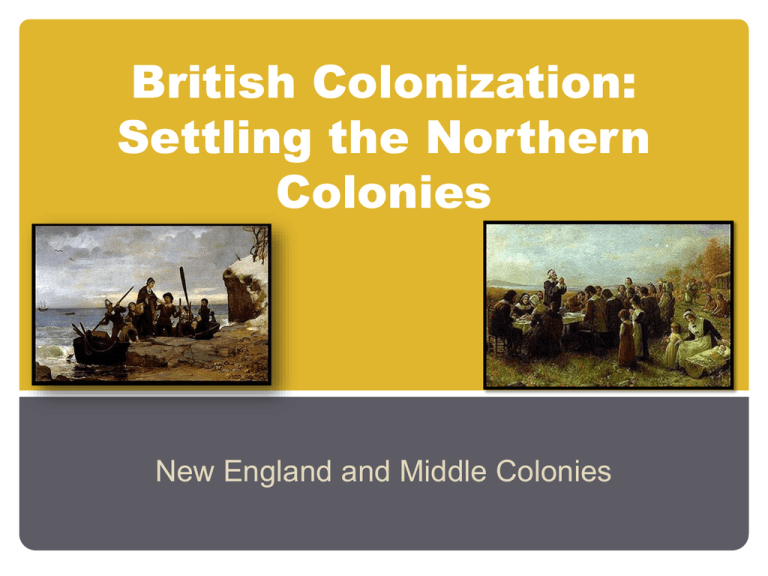
British Colonization: Settling the Northern Colonies New England and Middle Colonies Founding of Plymouth Bay: Early Activities of the Plymouth Company First company expedition was captured by Spanish in the West Indies (1606) Sir Ferdinando Gorges sent George Popham and Raleigh Gilbert to explore coast of Maine (1607) Trading and fishing activities sent to Maine John Smith explored New England coast for the company (1614): published A Description of New England- gave region its name Area rich in cod- revived interests of Plymouth Company James I (English King) gave charter to New England in 1620 Council for New England given rights to land between 40 and 48 degrees north and from ‘sea’ to ‘sea’ Puritanism Calvinism: Predestination. • Good works could not save those predestined for hell. • No one could be certain of their spiritual status. • Gnawing doubts led to constantly seeking signs of “conversion.” Puritans: Want to totally reform [purify] the Church of England. Grew impatient with the slow process of Protestant Reformation back in England. Separatists Separatist Beliefs: Puritans who believed only “visible saints” [those who could demonstrate in front of their fellow Puritans their elect status] should be admitted to church membership. Because the Church of England enrolled all the king’s subjects, Separatists felt they had to share churches with the “damned.” Therefore, they believed in a total break from the Church of England. Founding of Plymouth Rock James I required all Englishmen to attend services of the Anglican Church- no other services allowed Some Separatists migrated to Holland- granted limited asylum (1607) Some English Separatists feared their kids would lose contact w/ English culture as the years went by in Holland Negotiated w/ Virginia Co. to emigrate to lands in New World Group leaders secured rights to sail w/ Virginia Co. (1619) and settle w/in company borders The Mayflower Voyage: 22 July- 9 Nov 1620 1620 : a group of 102 people Negotiated with the Virginia Company to settle in its jurisdiction. Non-Separatists included Captain Myles Standish. (military leader) 30 pilgrims boarded Mayflower w/ adventurers & planters Landed outside of Virginia Co. land Technically, Pilgrims were squatters w/out land rights from King Mayflower Compact: 21 Nov. 1620 In response to non-Pilgrim assertions that no man had rights over others: Pilgrim leaders drafted Mayflower Compact, a social contract Set up a ‘civil body politic’ to ‘frame just and equal laws’ Signed by 41 adults- not all Pilgrims Not a constitution, but an agreement to form a crude govt. and submit to majority rule Led to adult male settlers meeting in assemblies to make laws in town meetings The Compact In the name of God, amen…We whose names are underwritten, the loyal subjects of our dread sovereign lord, King James, by the grace of God, of Great Britain, France, and Ireland King, Defender of the Faith, etc, having undertaken, for the glory of God, and advancement of the Christian faith, and honor of our King and country, a voyage to plant the first colony in the northern parts of Virginia, do by these presents solemnly and mutually, in the presence of God and one another, covenant and combine ourselves together into a ‘civil body politic’, for our better ordering and preservation and furtherance of the ends aforesaid; and by virtue hereof to enact, constitute, and ‘frame such just and equal laws’ ordinances, acts, constitutions, and offices, from time to time, as shall be thought most meet and convenient for the general good of the colony, unto which ‘we promise all due submission and obedience’ In witness whererof we have hereunto subscribed our names a Cape Cod the eleventh of November, in the reign of our sovereign lord, King James, of England, France, and Ireland, the eighteenth, and of Scotland, the fifty-fourth…..AD 1620. Plymouth Colony Plymouth chosen as site (Dec 25)- Deacon John Carver served as first governor Half of Pilgrims died w/in first 4 months Squanto & Samoset: Indians who taught Pilgrims to grow corn Friendship ensued, but Pilgrims dominated (they had guns) Roots of Thanksgiving celebration Celebrated after first corn harvest- 3-day event w/ 90-some men present Pilgrims militarized colony: Miles Standish leader after Virginia Massacre (1622) Pilgrims became agriculturally self-sufficient; still in debt after years of farming and fishing Abandoned communal farming in 1623 Settlement finally freed itself from debt & grew in population Significance of Pilgrims Helped inspire American vision of sturdy, selfreliant, God-fearing folk who govern themselves freely They foreshadowed methods later generations would use for mastery over Indians (firearms) Massachusetts Bay Colony 1629:non-Separatists got a royal charter to form the MA Bay Co. Wanted to escape attacks by conservatives in the Church of England. They didn’t want to leave the Church, just its “impurities.” 1630:1,000 people set off in 11 well-stocked ships Established a colony with Boston as its hub “Great Migration” of the 1630s Turmoil in England [leading to the English Civil War] sent about 70,000 Puritans to America. Not all Puritans -20,000 came to MA. John Winthrop Well-off attorney and manor lord in England. Became 1st governor of Massachusetts. Believed that he had a “calling” from God to lead there. Served as governor or deputy-governor for 19 years. PURITAN MIGRATION New England good harbors small farms and towns trade centered around harbors hilly, forested and shallow soil cities: Boston • 15,000 – 1750 fishing, lumber and trapping Family, religion and community Massachusetts, Rhode Island, New Hampshire, Connecticut Colonizing New England Pilgrims merge w/ Puritans to become part of Massachusetts Bay Colony Building the Bay Colony Franchise (right to vote) extended to “freemen” adult Puritan men of Congregational church (about 40% of men in the colony- higher percentage than in England) In town: all property -owning males could vote Town meetings a form of direct democracy Idea of gov’t to enforce God’s Laws • Therefore, religious leaders were influential (e.g.-John Cotton) • Clergy barred from political positions (separation from Church & State) Dissent in Bay Colony Social harmony when only Puritans lived in colony Roger Williams Arrived 1631- pastor of Salem Church Denied gov’t to regulate religious behavior Argued for a full break from Anglican Church Exiled in 1635 Rhode Island Roger Williams fled to Rhode Island territory w/ help of Indians founded new colony Started first Baptist Church in colonies Puritans wanted him exiled to England- would not have to fear a competitive colony forming Religious & political freedoms in Providence, RI Rhode Island more liberal than any other colony Known as ‘Sewer Colony’: Puritans saw Rhode Island as a dumping ground for dissenters, non-believers Anne Hutchinson Intelligent, well-spoken woman Challenged the Patriarchic society Held views of Antinomianism (opponents of rule of law)- placed on trial Her Beliefs: Believed in John Cotton’s theology that true Saints (born-agains) could only be governed by those who had undergone religious experience Hutchinson argued that saints must be free from interference by the nonelect (unborn agains)to launch into attacks on clergy authority She was dissatisfied w/ her minister, accused him of being non-elect in order to dispute his view She held meetings in her home after Church- men started to come to these gathering; thus a ‘woman was teaching a man’ This was subversive to the religious leaders of the colony Hutchinson was viewed as heretical and banished- left to Rhode Island New England Spreads Out Rhode Island founded by Roger Williams; opposed compulsory church service; did not necessarily believe in tolerance of all religions, but that the state would eventually corrupt the Church Hutchison and her family went to Rhode Island first, and then joined other Boston exiles in establishing Portsmouth New England Spreads Out Cont’ Fishing & trading = new communities; John Wheelwright banished from Mass.- establishes town of Exeter; Portsmouth & Exeter relinquish authority to Bay Colony in 1641; Wheelwright w/drew to Maine 1635: Hartford (Conn.) founded by Dutch/English settlers; some Puritans moved westward w/ Rev. Thomas Hooker Dominion of New England Goals: Bring colonies under England’s direct rule Defend colonies from French & Indian Stop colonial smuggling Sir Edmund Andros: King’s (James II) Representative Restricted town meetings Restricts on courts, press & schools Taxed people w/out consent of elected representatives Collapses after Glorious Revolution Population of New England Colonies Population Comparisons: New England & Chesapeake Middle Colonies New York, Pennsylvania, New Jersey & Delaware River systems Valleys – fertile soil "bread basket" large farms -surplus food diverse population manufacturing iron mines, glass, shipyards, and paper Cities: New York and Philadelphia Europeanizing America or Americanizing Europe? New Netherland (New York) 1609: Henry Hudson sailing for Dutch East India Company sails into Hudson river looking for passage through continent claims area for Dutch 1623-24: Dutch West India Company establishes New Netherland Goal: quick-profit fur trade “Bought” Manhattan from Indians Company town: no religious tolerance or free speech, harsh governors Colony had aristocratic influence Diverse population: 1640s- Missionary observed 18 languages Dutch Conflicts Dutch cruelties to Indians brought retaliatory massacres – Dutch built wall (Wall Street) Increased English settlement into Dutch territory and growth of Iroquois led to tensions Dutch settlements raided by Indians in 1640s Dutch resettled Long Island but frozen out of Connecticut (English settlers unwelcome) Connecticut rejected Dutch settlers New Netherland to New York English immigration to New Netherland resulted in 1/2 total population - English regarded Dutch as intruders Charles II brazenly granted area to his brother (Duke of York) No authority to do this, really English squadron comes, New Netherland leader, Peter Stuyvesant, governor of New York had no defense; surrendered, renamed New York New Sweden (New Jersey) Duke of York granted John Lord Berkeley and Sir George Carteret land between Hudson and Delaware Rivers Both proprietors allowed religious freedom and an assembly in addition to giving generous land offers to attract settlers Concessions and Agreements: granted freedom of conscience, generous land concessions and a general assembly of deputies elected by freeholders New Netherland & New Sweden William Penn Mid-1600s: religious dissenters named Quakers arose in England Hated by authorities because they refused to pay taxes to Church of England, refused to take oaths, refused military service Penn’s family owed a large debt from the British Crown. Given a land grant in 1681. Pennsylvania Penn governs the colony Advertised in Europe, promising land & freedoms Penn & Native Americans Pennsylvania & Neighbors Penn bought land from Indians treatment of them fair enough that Quakers went to them unarmed and even employed Indians as babysitters However, as non-Quaker immigrants came, they were less tolerant of Indians (Scots-Irish) Liberal features: elected assembly, no tax-supported church, freedom of worship, only 2 capital crimes
